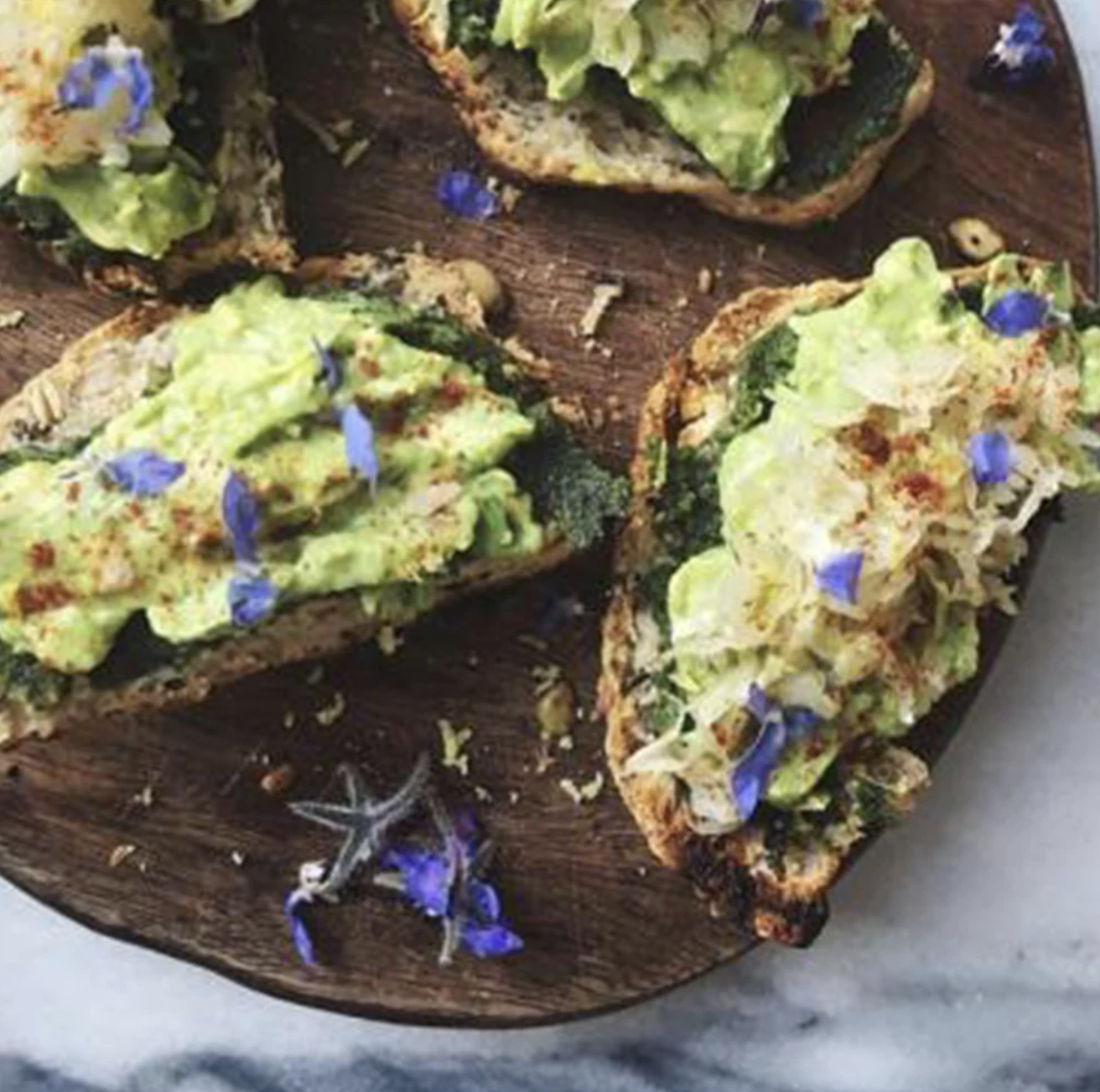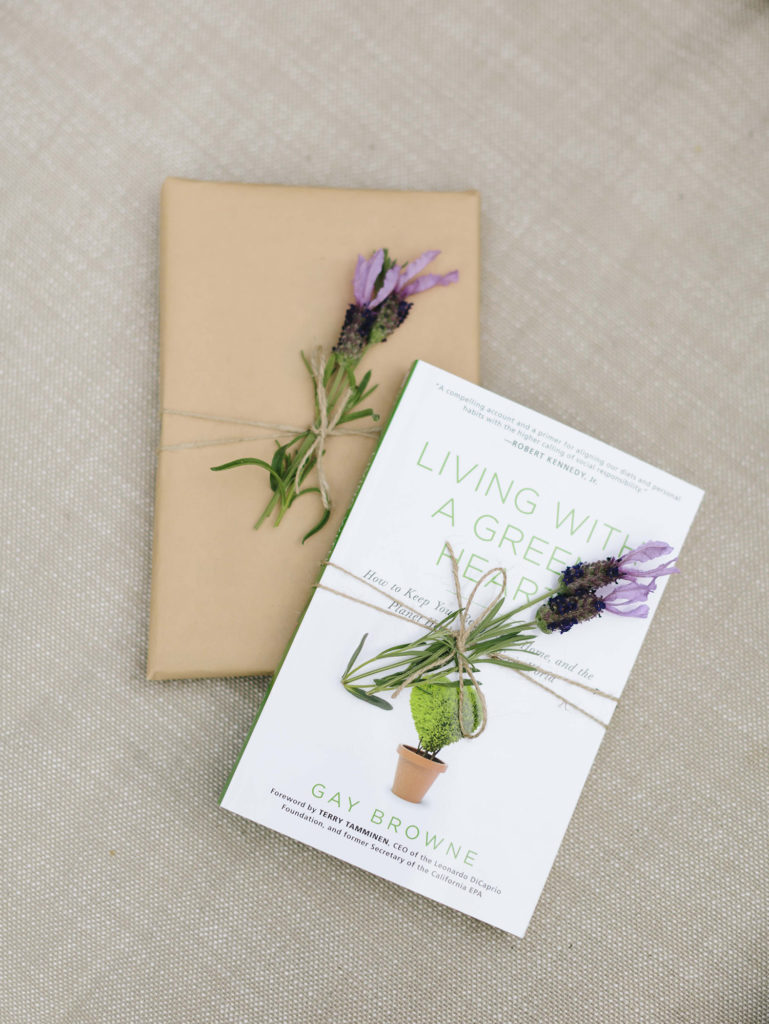
I am one with all that I put in my body
MANY OF MY LESSONS LEARNED from living with a green heart have been learned the hard way. Such is the case with food. After having an eating disorder as a teenager, I had to learn how to eat again after college. When your mind has learned to override your body’s hunger signals, it’s very hard to get back in touch with how it feels to be hungry and what foods are good for you. Once my doctor explained to me that eating is fuel for the body, I dove into researching what nutrition was derived from different foods. After I started learning how different foods fed my body, l began to understand how vital is the link between how food is grown and how it affects my health and that of the planet.
Today, I look at my food choices by prioritizing what my body needs and then work backward. Dr. Phil Goglia, the nutritionist whom I discovered while I was pregnant with my daughter, creates an individualized food plan based on your budget, your lifestyle, and a blood sample taken from a fingertip prick to determine your body type. A typical diet is composed of proteins, fats, grains, vegetables, fruits, and other foods. A plan for how to balance those elements can be tailored to your body type to achieve your personal best state of well-being. Allergies and other medical conditions such as diabetes are also taken into consideration, as well as cultural or ethical beliefs. As I’ve stated before in this book, I do not believe in a one-size-fits all approach to living life with a green heart, and that is certainly true when it comes to diets and nutritionists. There are many great doctors and nutritionists who I admire like Dr. Mark Hyman and Dr. Steven Gundry, who have written multiple books on health and nutrition. My diet borrows from them and others, always shifting a bit based on how I feel on a certain day or what is going on in my life at the time,or where I am. What is most important when it comes to food choice is for you to get to know your body so you can craft a diet that is right for you.
As we get into the next chapters, the one thing you will hear repeatedly is that it is not just what you eat that matters but also how that food is produced. Satish Kumar, in his book Soil, Soul, Society: A New Trinity for Our Time, talks about the necessity of healthy soil and how soil can help heal our planet. Soil is at the center of our universe, and the way in which food is grown is at the core of a healthy individual and a healthy society. However, many of the farming methods being used today are creating degenerate environments that are destroying that soil. It’s something that has been going on for generations but has now been exacerbated due to some corporate farming practices and the wider use of chemicals in modern farming.
As our relationship to the farmers who produce our food grows more distant, it’s important to understand why we must support those growers who have committed to producing food in a manner that regenerates the Earth. The Carbon Underground and Regenerative Agriculture Initiative at California State University, Chico, defines regenerative agriculture as “farming and grazing practices that, among other benefits,reverse climate change by rebuilding soil organic matter and restoring degraded soil biodiversity—resulting in both carbon drawdown and improving the water cycle.” In his book, Project Drawdown, Paul Hawken promotes farming practices that draw carbon down into the soil one of his one hundred solutions to reduce climate change. Regenerative agriculture treats the land more holistically. Instead of focusing solely on crop yields, it takes an integrated approach to farming by nurturing the soil’s natural tendencies rather than depleting them. Instead of pesticides, chemical fertilizers, fumigants, and genetically modified organisms (GMOs), regenerative agriculture uses a set of farming principles based on working with nature, rather than trying to control it.
Biodynamic farming is also gaining in popularity. By definition it is a holistic, ecological, and ethical approach to farming, gardening, food, and nutrition based on the spiritual insights and practical suggestions of the noted philosopher Rudolf Steiner. We’ll talk more about biodynamic farming when we talk about wine, an area that is leading the way in this type of farming and is producing a superior product as a result.
While biodynamic and regenerative practices can go a long way in reversing the damage of over-farming and can improve soil conditions, the biggest challenge to the planet posed by mass food production is water usage. It is estimated that agriculture accounts for more than 30 percent of our total water usage. Water maintains all living things, yet it is a rapidly dwindling resource. Supporting farms that are committed to regenerative and/or
| Eco-Heroes: Ryland Engelhart and Finian Makepeace Kiss the Ground’s mission is to inspire global regeneration, starting with soil. In the spring of 2013, Ryland Engelhart, co-owner of Cafe Gratitude, heard about soil as a solution to climate change from Graeme Sait, a New Zealand farming educator. Ryland learned that building healthy soil has the miraculous ability to sequester carbon from the atmosphere, and knew in his heart it was a story that had to be shared with the world. And it’s not just carbon storage; the ways that soil stands to positively impact lives of billions worldwide are tangible and immediate: replenished water cycles, restored fertility, regenerated ecosystems. Ryland told Finian Makepeace, a childhood friend and professional musician, and together they began telling others about the power of Today, they are an NGO that has had over 50 million unique impressions with “Regenerative” content. They have influenced global thought leaders, major food brands and educational institutions. Their four programs include: Media, Farmer Scholarships, Education Curriculum and Advocacy. They have co-produced a feature length documentary film called Kiss The Ground, due out in 2019. knowledge of their waterways with an unwavering commitment to the rights of their communities. |
biodynamic farming practices in combination with good water and wastewater hygiene is truly an act of living with a green heart. Remember, vote with your dollar – shift market change towards responsible farming. The benefits will be felt by all, including animals.
Living With A Green Heart
“Living with a Green Heart” by Gay Browne is a thought-provoking and inspiring guide for anyone looking to positively impact the planet. Through her own personal journey towards sustainability, Browne invites readers to explore the ways in which our daily choices can have a significant impact on the environment and our own well-being.
With a gentle and encouraging tone, Browne offers practical tips and advice on everything from reducing waste to eating a more plant-based diet. She shares her experiences living a more sustainable lifestyle and her lessons.
What makes “Living with a Green Heart” truly revolutionary is Browne’s emphasis on the connection between environmentalism and personal growth. She shares that by living in harmony with nature, we can improve not only the health of the planet but also our own mental and emotional well-being.
Overall, “Living with a Green Heart” is a must-read for anyone looking to live a more sustainable and fulfilling life. Browne’s passion for the environment and practical advice make this book an engaging and compelling call to action.

